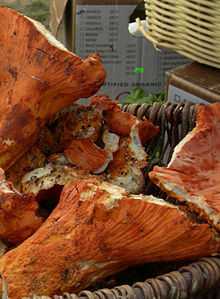Hypomyces lactifluorum
| Lobster mushroom | |
|---|---|
 | |
| Scientific classification | |
| Kingdom: | Fungi |
| Division: | Ascomycota |
| Class: | Sordariomycetes |
| Order: | Hypocreales |
| Family: | Hypocreaceae |
| Genus: | Hypomyces |
| Species: | H. lactifluorum |
| Binomial name | |
| Hypomyces lactifluorum (Schwein.) Tul. & C.Tul. | |
The Lobster mushroom, Hypomyces lactifluorum, contrary to its common name, is not a mushroom, but rather a parasitic ascomycete fungus that grows on certain species of mushrooms, turning them a reddish orange color that resembles the outer shell of a cooked lobster. H. lactifluorum specifically attacks members of the genera Lactarius and Lactifluus (milk-caps), and Russula (brittlegills), such as Russula brevipes and Lactifluus piperatus in North America. At maturity, H. lactifluorum thoroughly covers its host, rendering it unidentifiable. Lobster mushrooms are widely eaten and enjoyed; they are commercially marketed and are commonly found in some large grocery stores. They have a seafood-like flavor and a firm, dense texture. According to some, they may taste somewhat spicy if the host mushroom is an acrid Lactarius.
External links
| Wikimedia Commons has media related to Hypomyces lactifluorum. |